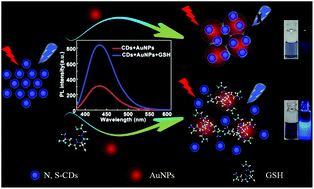A photoluminescence “switch-on” nanosensor composed of nitrogen and sulphur co-doped carbon dots and gold nanoparticles for discriminative detection of glutathione†
Abstract
Biological thiols play a key role in biological processes and are involved in a variety of diseases. The discriminative detection of biological thiols is still challenging. In this contribution, a platform, an energy transfer-based quenching system composed of nitrogen and sulphur co-doped carbon dots (N, S-CDs) and gold nanoparticles (AuNPs), was established to discriminate glutathione (GSH) from other competitive biothiols including cysteine (Cys) and homocysteine (Hcy) based on a photoluminescence (PL) “switch-on” signal readout. The presence of GSH can encapsulate AuNPs in priority because of the strong affinity towards AuNPs and the steric hindrance effect of GSH, leaving little chance for the N, S-CDs binding on the surface of AuNPs and thus resulting in the PL recovery of N, S-CDs. Compared with the nitrogen-doped carbon dots (N-CDs), the N, S-CDs can enhance 10 times sensitivity for the designed PL “switch-on” sensing strategy. The proposed method has a detection limit of 3.6 nM and can be successfully applied for the detection of GSH in human serum.



 Please wait while we load your content...
Please wait while we load your content...